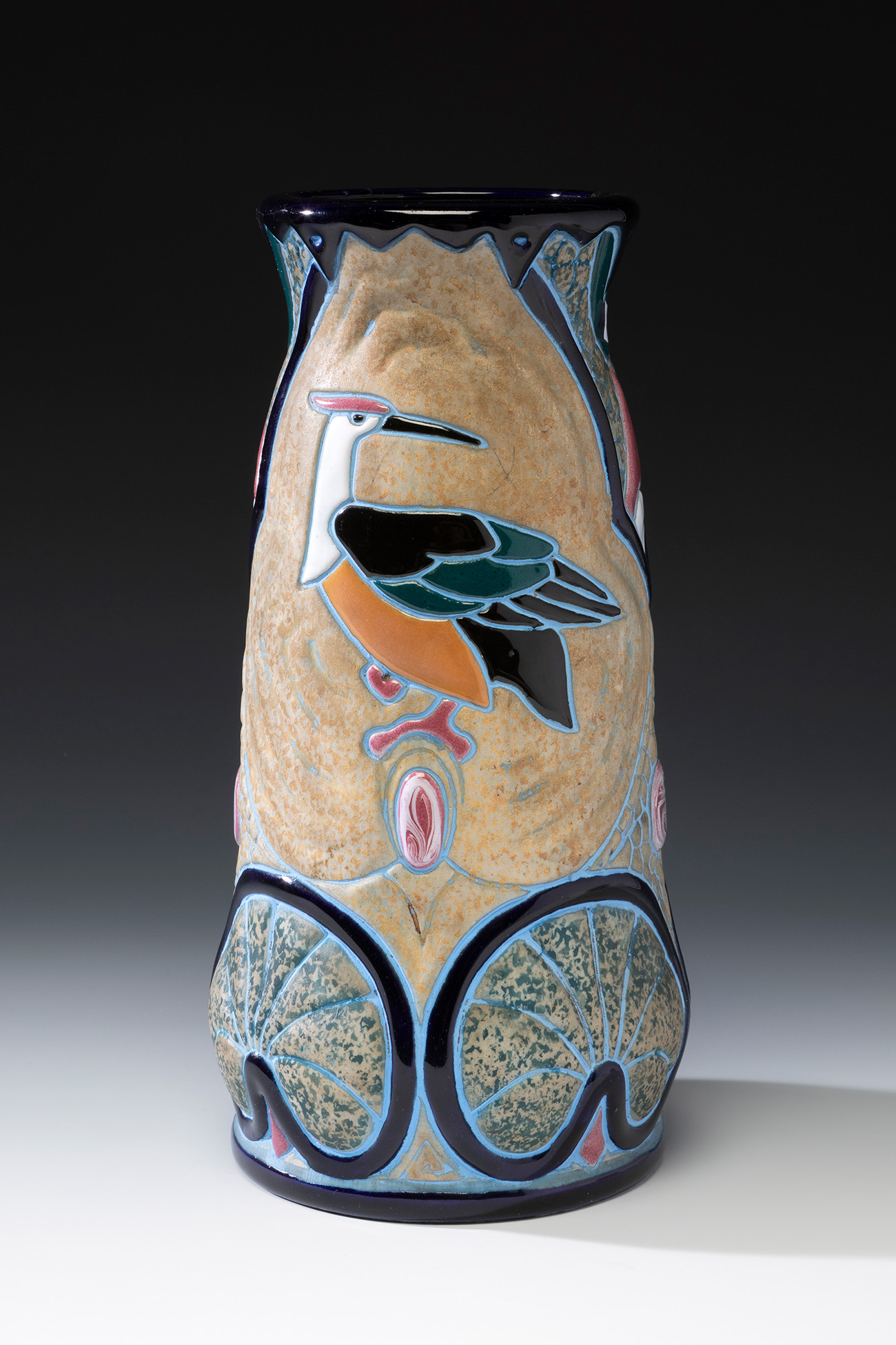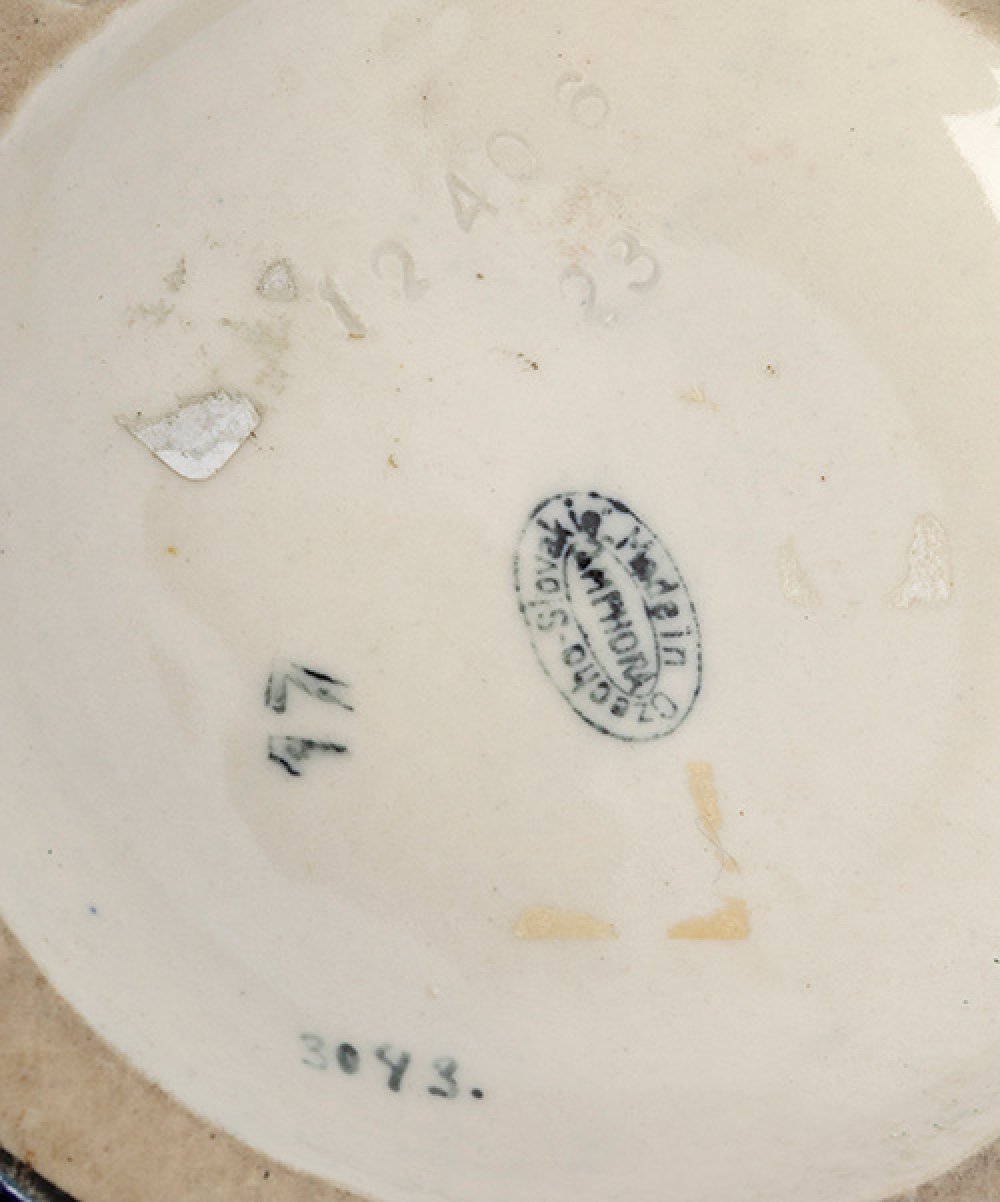21
Enamelled porcelain.A vase from the Czechoslovakian manufacture of Anphora, Reissner Stellmacher and
A vase from the Czechoslovakian manufacture of Anphora, Reissner Stellmacher and Kessel factory, decorated with birds and geometric decoration. It belongs to the decorative series also known as Campina, a name derived from the Latin CAMPUS, alluding to the design, composed of clearly differentiated enamelled areas. The design and production of this popular and much-loved series began in 1909 under the guidance of Max Von Jungwirth, a professor of drawing and decorative painting.
Marks and numbering on the reverse.
Similar models published in the book "The House of Amphora" by Richard L. Scott.
Provenance: Spanish private collection, formed between 1970 and 2010.
Good condition. Normal wear and tear due to use and the passage of time.
Measurements: 26 cm (height) x 13 cm (largest diameter).
In 1892, after 17 years as a leading ceramics producer, Alfred Stellmacher encouraged his son and sons-in-law to establish a porcelain factory. Named after its owners Riessner, Stellmacher and Kessel (RSt&K), and employing his son-in-law Paul Dachsel, the firm consistently marked pieces with the word Amphora in the late 1890s and subsequently became known by that name. The Amphora factory was located in Turn-Teplitz, Austria (now in the Czech Republic). Once a spa town that attracted the likes of Goethe and Beethoven, Teplitz had lost its lustre over time due to the increasing intrusion of industrial activity. Turn, which had served Teplitz's spa lovers with diversions that included lush gardens and beautiful villas, was also affected by gradual industrialisation. In the mid-19th century, the area formed a de facto ceramics production centre that was also home to Kunstkeramik Paul Dachsel, Eduard Stellmacher and Ernst Wahliss. Porcelain factories found the region advantageous because the local riverbeds provided an abundant supply of kaolin, an essential ingredient of porcelain. The rivers themselves were sources of energy, and nearby railways facilitated the rapid sale and export of ceramics throughout Europe. When originally incorporated, Amphora imitated the Orientalist and Neo-Baroque styles favoured by Alfred Stellmacher. The combined talents of skilled designers such as Eduard Stellmacher, Paul Dachsel and a host of decorators from the Teplitz Special School of Ceramics enabled the Amphora manufactory to rapidly develop a unique genre of Art Nouveau ceramics. What unified its production was an unparalleled concern for fine design and high quality, as well as Alfred Stellmacher's use of "ivory porcelain", a yellowish matt material that was malleable, but resistant to high temperatures. Amphora's stylistic diversity, combined with its uncompromising standard of quality, made it a world leader among industrial manufacturers of artistic ceramics. An important series of a remarkable decade, from 1894 to 1904, features plants (including applied flowers and fruits), animals, mythical creatures, Klimt and Mucha-style portraits, biomorphic designs and simulated jewellery. The departure of Paul Dachsel in 1903 and Eduard Stellmacher in 1904 marked the end of Amphora's golden age.
A vase from the Czechoslovakian manufacture of Anphora, Reissner Stellmacher and Kessel factory, decorated with birds and geometric decoration. It belongs to the decorative series also known as Campina, a name derived from the Latin CAMPUS, alluding to the design, composed of clearly differentiated enamelled areas. The design and production of this popular and much-loved series began in 1909 under the guidance of Max Von Jungwirth, a professor of drawing and decorative painting.
Marks and numbering on the reverse.
Similar models published in the book "The House of Amphora" by Richard L. Scott.
Provenance: Spanish private collection, formed between 1970 and 2010.
Good condition. Normal wear and tear due to use and the passage of time.
Measurements: 26 cm (height) x 13 cm (largest diameter).
In 1892, after 17 years as a leading ceramics producer, Alfred Stellmacher encouraged his son and sons-in-law to establish a porcelain factory. Named after its owners Riessner, Stellmacher and Kessel (RSt&K), and employing his son-in-law Paul Dachsel, the firm consistently marked pieces with the word Amphora in the late 1890s and subsequently became known by that name. The Amphora factory was located in Turn-Teplitz, Austria (now in the Czech Republic). Once a spa town that attracted the likes of Goethe and Beethoven, Teplitz had lost its lustre over time due to the increasing intrusion of industrial activity. Turn, which had served Teplitz's spa lovers with diversions that included lush gardens and beautiful villas, was also affected by gradual industrialisation. In the mid-19th century, the area formed a de facto ceramics production centre that was also home to Kunstkeramik Paul Dachsel, Eduard Stellmacher and Ernst Wahliss. Porcelain factories found the region advantageous because the local riverbeds provided an abundant supply of kaolin, an essential ingredient of porcelain. The rivers themselves were sources of energy, and nearby railways facilitated the rapid sale and export of ceramics throughout Europe. When originally incorporated, Amphora imitated the Orientalist and Neo-Baroque styles favoured by Alfred Stellmacher. The combined talents of skilled designers such as Eduard Stellmacher, Paul Dachsel and a host of decorators from the Teplitz Special School of Ceramics enabled the Amphora manufactory to rapidly develop a unique genre of Art Nouveau ceramics. What unified its production was an unparalleled concern for fine design and high quality, as well as Alfred Stellmacher's use of "ivory porcelain", a yellowish matt material that was malleable, but resistant to high temperatures. Amphora's stylistic diversity, combined with its uncompromising standard of quality, made it a world leader among industrial manufacturers of artistic ceramics. An important series of a remarkable decade, from 1894 to 1904, features plants (including applied flowers and fruits), animals, mythical creatures, Klimt and Mucha-style portraits, biomorphic designs and simulated jewellery. The departure of Paul Dachsel in 1903 and Eduard Stellmacher in 1904 marked the end of Amphora's golden age.
5th September - Art Nouveau & Art Decó Glass Collection
Sale Date(s)
Venue Address
General delivery information available from the auctioneer
Setdart offers Worldwide shipping
PICK UP IN ROOM: You can come and pick up your lots in our offices (Barcelona, Madrid or Valencia). At the moment of the withdrawal, you will be able to accept the current conditions of the lot by means of a document that you will sign.
YOU CAN SEND ANOTHER PERSON TO PICK UP: This person must present a signed authorization that you can find in our web page by accessing from BUY AT SETDART- LOGISTICS-DOWNLOAD AUTHORIZATION DOCUMENT. You can also send an e-mail with the requested data in AUTHORIZATION DOCUMENT to admin@setdart.com
Important Information
25% buyer´s premium
21% buyer´s premium at www.setdart.com
Terms & Conditions
The maximum period to pay the lots is 7 working days. You can pay either via bank transfer or with credit card through our platform www.setdart.com (we only accept VISA or Mastercard).
BUYER´S PREMIUM: 22% Hammer price + 21% VAT from the buyer´s premium
If your piece has more than 100 years, our Ministry of Culture requires an export certificate in order for the piece to leave the country. Note that if the piece goes inside the EU, there is no cost for the export certificate. If the piece goes outside the EU, there is a cost for the export certificate. You can find more information in our Ministry of Culture website: https://www.culturaydeporte.gob.es/en/cultura/patrimonio/exportacionimportacion/exportacion/tasas.html
INQUIRIES: admin@setdart.com
Setdart guides you through the entire process, from the time of award to the day you receive your lot. Our logistics team will be happy to manage your transport, and will advise you on the best shipping method with professionals from the sector used to handling works of art and jewelry.
WE OFFER WORLDWIDE DOOR TO DOOR SHIPPING
PICK UP IN ROOM: You can come and pick up your lots in our offices. At the moment of the withdrawal, you will be able to accept the current conditions of the lot by means of a document that you will sign.
YOU CAN SEND ANOTHER PERSON TO PICK UP: This person must present a signed authorization that you can find in our web page by accessing from BUY AT SETDART-LOGISTICS-DOWNLOAD AUTHORIZATION DOCUMENT. You can also send an e-mail with the requested data in AUTHORIZATION DOCUMENT to admin@setdart.com
SETDART IS NOT RESPONSIBLE FOR THE STATE OF THE PARTS ONCE THEY LEAVE OUR FACILITIES. MRW SHIPMENTS: Once the payment is made, your lot will be packed for shipment, the logistics department will send you an e-mail notifying you of the day it leaves our warehouse, changes of address cannot be made after receiving this e-mail.
INSURANCE INCIDENTS: Coverage for the value of the auction up to 3000 ? per shipment, if the value of the auction is higher, Setdart will send you a quote including the additional insurance. The insurance company WILL NOT BE RESPONSIBLE FOR THE SHIPMENT THAT EXCEEDS THAT AMOUNT AND IS NOT FULLY INSURED. MRW INCIDENTS: Maximum notification 48 hours after receipt, after which the insurance company WILL NOT BE RESPONSIBLE AND NO CLAIMS WILL BE ACCEPTED.
E-MAIL LOGISTICS: logistica@setdart.com
PICK UP YOUR MESSAGES: You can send your own messaging, prior notice via e-mail that your shipment is ready, please note 3 or 4 days in advance. This type of shipment is packaged so Setdart will provide you with a quote.
EXPENSES FOR STORAGE: We inform you that if the purchased lot is not picked up within a month, you will be charged 30€ per week per lot. Setdart Online S.L., owner of the web site "setdart.com", "setdart.net" and "setdart.org", acts as a company of Spanish nationality inscribed in the Volume 36955, sheet 182, page B-293056 of the Mercantile Registry, with registered office at Calle Aragó









